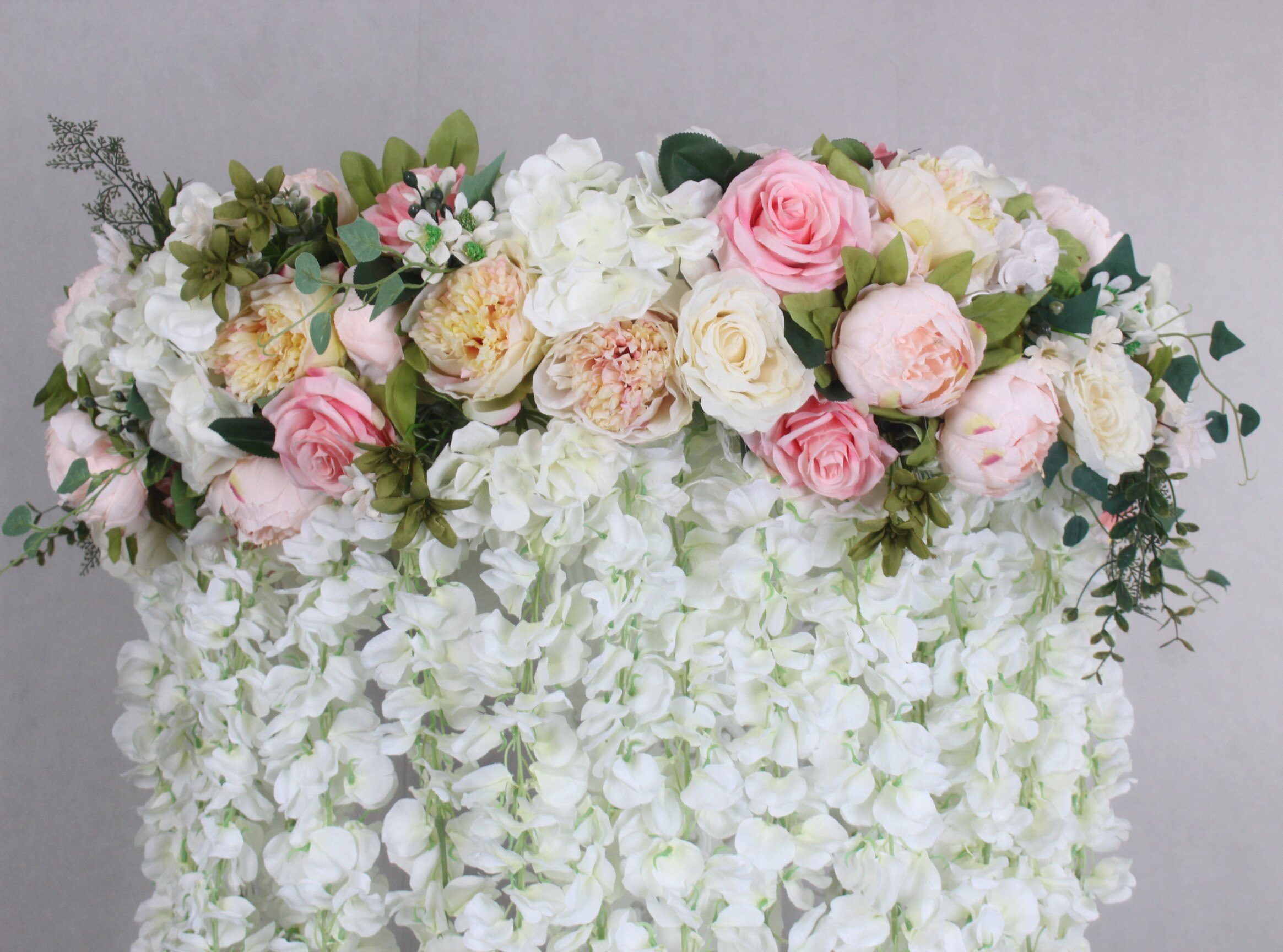how to make a flower wall stand up?
To make a flower wall stand up, you can use a variety of methods depending on the size and weight of the wall. One option is to use a freestanding frame made of PVC pipes or metal rods. Attach the flowers to a mesh or wire grid that can be secured to the frame. Another option is to use a sturdy backdrop stand or a wooden frame that can be propped up against a wall or secured to the ground. Attach the flowers to the frame using floral wire or zip ties. Additionally, you can use a combination of hooks, nails, or adhesive strips to attach the flowers directly to a wall or surface. Make sure to distribute the weight evenly and secure the flowers properly to ensure stability.
1、 Choosing the right materials for a sturdy flower wall
Choosing the right materials for a sturdy flower wall is essential to ensure it stands up properly. Flower walls have become increasingly popular in recent years, adding a touch of elegance and beauty to various events such as weddings, parties, and photo shoots. To make a flower wall stand up, consider the following steps:
1. Frame: Start by selecting a sturdy frame that will provide support for the flower wall. Options include wooden frames, metal grids, or PVC pipes. Ensure the frame is strong enough to hold the weight of the flowers and any additional decorations.
2. Base: Create a stable base for the flower wall by attaching the frame to a solid surface such as a wall, fence, or freestanding structure. This will prevent the flower wall from toppling over.
3. Backing: Choose a suitable backing material to attach the flowers to. Options include chicken wire, floral foam, or a mesh grid. The backing should be strong enough to hold the weight of the flowers and allow for easy attachment.
4. Flowers: Select high-quality artificial or fresh flowers that are lightweight but durable. Artificial flowers are often preferred for their longevity and ease of maintenance. Ensure the flowers are securely attached to the backing using floral wire, zip ties, or hot glue.
5. Maintenance: Regularly check the flower wall for any loose or wilting flowers and replace them as needed. Keep the flower wall away from direct sunlight and extreme weather conditions to maintain its appearance.
In conclusion, making a flower wall stand up requires choosing the right materials that provide a sturdy frame, stable base, and suitable backing. By following these steps and considering the latest trends and materials available, you can create a beautiful and long-lasting flower wall for any occasion.

2、 Building a stable frame for the flower wall
Building a stable frame for a flower wall is essential to ensure it stands up securely and remains intact. Here's a step-by-step guide on how to make a flower wall stand up:
1. Determine the size and location: Measure the area where you want to place the flower wall and decide on the dimensions. Consider the weight and size of the flowers you plan to use.
2. Choose the materials: Select sturdy materials such as PVC pipes, wooden boards, or metal frames. PVC pipes are lightweight and easy to work with, while wooden boards provide a more rustic look. Metal frames offer durability and stability.
3. Cut and assemble the frame: Cut the materials to the desired dimensions and assemble them into a rectangular or square shape. Use connectors, screws, or adhesive to secure the joints. Ensure the frame is level and stable.
4. Reinforce the frame: Depending on the size and weight of the flower wall, consider adding additional support. This can be done by adding crossbars or diagonal braces to strengthen the frame.
5. Attach a backing: To provide a surface for attaching the flowers, attach a sturdy backing material such as chicken wire or mesh to the frame. This will help hold the flowers in place and prevent them from falling off.
6. Mount the flower wall: Once the frame is complete, position it in the desired location. Use hooks, brackets, or stands to secure the flower wall to the wall or floor, ensuring it is stable and won't tip over.
7. Add the flowers: Start attaching the flowers to the backing material using floral wire, zip ties, or hot glue. Arrange them in a pattern or design of your choice, ensuring they are evenly distributed and securely attached.
By following these steps, you can create a stable frame for your flower wall, allowing it to stand up securely and provide a beautiful backdrop for any occasion.

3、 Attaching flowers securely to the wall
To make a flower wall stand up, there are a few key steps to follow. The first step is to choose a sturdy and stable wall surface that can support the weight of the flowers. It is important to ensure that the wall is clean and free from any debris or loose paint, as this can affect the adhesion of the flowers.
Next, you will need to attach a backing material to the wall. This can be done using adhesive hooks, nails, or screws, depending on the type of wall and the weight of the flowers. It is recommended to use a lightweight backing material, such as foam board or plywood, as it will provide a solid surface for attaching the flowers.
Once the backing material is securely attached to the wall, you can begin attaching the flowers. There are several methods you can use to do this. One popular method is to use floral foam or oasis, which can be soaked in water and then attached to the backing material using floral wire or hot glue. This allows you to easily insert the flower stems into the foam, creating a secure and stable arrangement.
Another method is to use adhesive hooks or strips to attach the flowers directly to the backing material. This can be a quick and easy way to create a flower wall, but it may not be as secure as using floral foam.
It is important to note that the longevity of a flower wall will depend on the type of flowers used and the care taken to maintain them. Some flowers may wilt or fade more quickly than others, so it is important to choose flowers that are known for their longevity and to regularly mist them with water to keep them fresh.
In conclusion, making a flower wall stand up involves choosing a sturdy wall surface, attaching a backing material, and securely attaching the flowers using methods such as floral foam or adhesive hooks. Regular maintenance and care will help ensure the longevity of the flower wall.

4、 Ensuring proper weight distribution for stability
To make a flower wall stand up, ensuring proper weight distribution for stability is crucial. Here are some steps to achieve this:
1. Choose a sturdy base: Start by selecting a solid and stable base for your flower wall. This could be a freestanding wall, a wooden frame, or a metal grid. Ensure that the base is strong enough to support the weight of the flowers and any additional decorations.
2. Secure the base: Once you have your base, make sure it is securely anchored to the ground or wall. This will prevent any wobbling or tipping over. Use screws, brackets, or other appropriate fasteners to secure the base firmly in place.
3. Use lightweight materials: When constructing the flower wall, opt for lightweight materials that won't add unnecessary weight. Foam boards, mesh panels, or wire grids are popular choices. These materials are not only lightweight but also provide a stable surface for attaching the flowers.
4. Distribute weight evenly: As you attach the flowers to the wall, ensure that the weight is distributed evenly across the entire structure. Concentrated weight in one area can cause instability. Consider using a mix of flowers, foliage, and other decorative elements to evenly distribute the weight.
5. Reinforce the structure: If needed, reinforce the structure by adding additional support. This could include adding extra screws or brackets, reinforcing joints, or using additional stabilizing elements such as sandbags or weights at the base.
The latest point of view emphasizes the use of sustainable and eco-friendly materials in constructing flower walls. Consider using recycled or biodegradable materials for the base and attaching the flowers with eco-friendly adhesives or wire. This not only ensures stability but also promotes environmental consciousness.










































Leave your comment